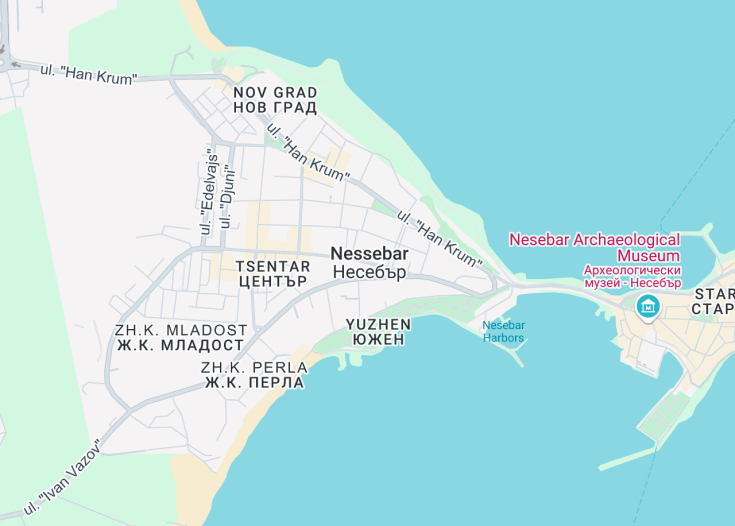Nestled on a small peninsula on the Black Sea coast, Nessebar, Bulgaria, is a captivating blend of history and beauty. This ancient town, one of Europe’s oldest, is distinguished by its medieval churches, narrow cobblestone streets, and picturesque ruins, earning it a UNESCO World Heritage site designation.
The harmonious blend of Byzantine and Bulgarian medieval architecture creates a unique aesthetic atmosphere, making Nessebar not just a destination but a timeless journey through eras gone by.
For an enriching experience, plan a visit during the off-season when Nessebar is less crowded, offering a more authentic glimpse into its historical charms.
Don’t miss a sunset walk along the town’s ancient fortifications, where panoramic sea views and historic ambiance combine for unforgettable moments.
Top things to do & see in Nessebar
Select the following sights and activities to discover best tickets and tours available in Nessebar.
Nessebar: A Glimpse into the Past
| Country | Bulgaria |
| Time in Nessebar | GMT+2 |
| Language spoken | Bulgarian |
| Population | 11,626 (National Statistical Institute of Bulgaria, 2021) |
| Currency | Bulgarian Lev (BGN, лв) |
| Airports |
|
Nessebar, a UNESCO World Heritage site, spans 3,000 years with its rich trove of historic ruins and medieval architecture, making it a captivating portal to Bulgaria’s diverse past.
Where is Nessebar?
Nessebar is located in southeast Bulgaria, on the Black Sea coast, near the town of Burgas.
Distances:
| Route | Distance by car | Time by car |
|---|---|---|
| Burgas to Nessebar | 23 mi | 40 min |
| Sofia to Nessebar | 243 mi | 5 hours |
| Varna to Nessebar | 64 mi | 1 hour 38 mins |
What is Nessebar famous for?
Known for its maze of cobbled streets, ancient churches, and beautifully preserved medieval architecture, Nessebar is often dubbed as the ‘Pearl of the Black Sea’.
History
Ancient Settlements and Greek Influence (Thracian Era – 6th Century BC)
Nessebar, originally known as Mesembria, begins its recorded history as a Thracian settlement before becoming a Greek colony in the 6th century BC. During this period, the city was an important center for trade and naval prowess, due in part to its strategic position on the Black Sea coast. The city’s architecture and coinage bear testament to its early prosperity and cultural exchange with other Greek city-states.
Byzantine Dominance & the Bulgarian Empire (6th Century – 14th Century)
As the Roman Empire waned, Nessebar came under the influence of the Byzantine Empire, and later, it became a valuable part of the First Bulgarian Empire after 812 AD. Throughout these centuries, Nessebar flourished as a cultural and religious hub. Numerous churches were built in this era, many of which remain standing, reflective of the characteristic Byzantine and Bulgarian architectural styles.
Ottoman Rule and Cultural Transformation (14th Century – 19th Century)
Falling under Ottoman rule in the late 14th century, Nessebar endured significant changes. The city saw a gradual decline in its economic stature as trade routes shifted. Despite this, Nessebar preserved its architectural heritage and continued to serve as a center of Christian orthodoxy, with several new churches built during this period.
Modern Renovation and Tourism (20th Century – Present)
The 20th century heralded a new era for Nessebar as efforts to preserve its rich historical legacy intensified. The city’s inclusion in the UNESCO World Heritage list marked a turning point, promoting restoration works and boosting tourism. Today, Nessebar is celebrated not only for its historical significance but also as a cherished destination for cultural tourism, attracting visitors worldwide with its ancient ruins and picturesque maritime setting.
Visit Nessebar
What to see and do in Nessebar
Explore the rich tapestry of history and relaxation in Nessebar. Stroll through the cobbled streets of the Old Town to discover a myriad of preserved churches like the Church of St. Sophia and the Church of St. John Aliturgetos, each telling a unique story of the past.
Don’t miss the Nessebar Archaeological Museum for a deeper dive into the city’s history. For a change of pace, enjoy the beautiful beaches of the Black Sea, offering both quiet retreats and vibrant water sports.
- Walking tours through ancient ruins
- Visits to centuries-old churches
- Relaxing by the scenic Black Sea beaches
- Cultural experiences such as folk music and dances
Festivals and Events in Nessebar
Nessebar’s cultural calendar is highlighted by events such as the Summer Festival of Arts. Running from June to September, this festival features concerts, exhibitions, and performances, celebrating Bulgarian and international art forms. The city also hosts traditional folklore festivals, offering visitors a glimpse into the rich cultural heritage of the region.
Best time to visit Nessebar
The ideal time to visit Nessebar is during the late spring to early autumn months, from May to October, when the weather is pleasantly warm, and the full spectrum of tourist attractions and events are operational, enhancing the experience of its historical and natural beauty.
Is Nessebar worth visiting?
Indeed, Nessebar is worth visiting. This ancient city is a rare blend of history, culture, and scenic beauty, making it a unique spot on the Bulgarian Black Sea coast.
The preserved historical architecture, combined with the vibrant cultural scene and beautiful beaches, offers something for everyone, whether you are a history enthusiast, culture seeker, or simply looking for a picturesque escape.










